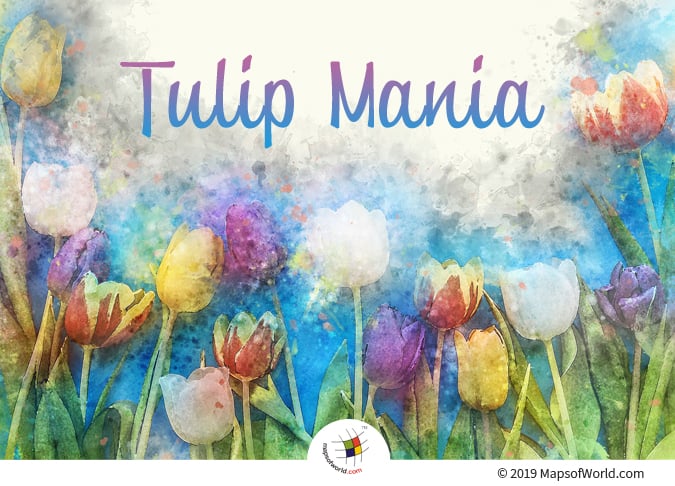

The Netherlands also has the world’s largest and permanent display of tulips at Keukenhof.
Netherlands is sometimes called the “flower shop of the world”, due to the great variety and diversity of flowers, especially tulips, that are cultivated in its legendary flower fields. In the 17th century, the tulip flowers became one of the most important contributors to the Dutch economy. The infamous economic crash in the Dutch Economy due to the tulips is known as “the tulip mania”. It occurred during the early 1600s when the value of tulip bulbs rose to extremes. At that time, the rarest tulip bulbs cost the equivalent of a house, and sometimes as much as six times an average person’s annual salary.
The tulips were introduced to Europe by the ambassador of the Holy Roman Empire to the Sultan of Turkey. He sent the first tulip bulbs and seeds to Vienna in 1554. From there, they were soon distributed and reached the Netherlands. In 1593, a Flemish botanist named Carolus Clusius established a horticultural academy at the University of Leiden. There he began the cultivation of tulips, and demonstrated that tulips could be easily grown in the harsher climate of the country.
Since the tulips originally belonged to Turkey, they looked like no other native flower of the continent. It is no surprise then that this was the reason behind the popularity of the tulips. They became a luxury item destined to become a status symbol at the same time. Meanwhile, the Dutch people learned that tulips grew from mother bulbs. Soon, they started cultivating these flowers. It took seven to twelve years for a tulip to flower from a seed, but it took only a year to flower from a mother bulb.
People evolved a new “broken bulb” which was actually a new type of tulip. They had a multicolored pattern rather than a single color which gave them a mosaic look. This variety became quite popular and the rising demand for it led to a high market price. It triggered a rage amongst the Dutch people to possess these rare tulip bulbs. In 1634, this tulip mania swept through Holland on a large scale. It was so massive that the ordinary industries of the country got neglected, while tulip trade was the only one which flourished. A single tulip bulb (best in quality) at that time cost about nearly $750,000 in today’s money. The demand for tulip trade was so high that regular marts were established on the Stock Exchange of Amsterdam, Haarlem, Rotterdam and other towns in 1636. People began buying tulips with leverage from professional traders, and its price started skyrocketing.
Vast sums were involved in tulip trading during this period. Tulip bulbs became a proxy for currency, with people exchanging tulip bulbs instead of paying money. This activity, including people who speculated in the tulip trade, soon became an object of ridicule. Even pamphlets and prints were distributed to intensify the effect. Finally, because of this, the situation was brought under control.
In 1637, the sky-high price of tulip bulbs started dropping and it never saw a rise again. A rapid decline was seen because people had purchased tulip bulbs on credit. They hoped to repay their loans, but soon the holders were forced to liquidate and sell their bulbs at lower prices. This made them poor, forcing many to declare bankruptcy in the process. By the end of 1637, the market fell apart and there ensued a devastating phase for the nation’s economy. This ‘tulip mania’ ultimately crashed the economy.
It is to be noted that despite the crash in 1637, the interest in tulips bulbs remained quite undiminished. Though the price dropped, the popularity remained. Growers in the west of Holland continue to develop new varieties of tulips till today. The cultivated forms of the tulips are often regarded as the ‘Dutch Tulips’ all over the world. The Netherlands also has the world’s largest and permanent display of tulips at Keukenhof, which is thrown open during the flowering season, from late-March to mid-May. Tulips and their bulbs are still available everywhere in the Netherlands, and remain one of the most popular gifts.
Related Links:
The Republic of Madagascar is an island country located in the Indian Ocean, off the…
The Euro is the official currency of the European Union. It is, however, not incumbent…
There are many countries or regions that are partially recognized by the UN, have disputes…
The Alaska Statehood Act was signed into law by President Dwight D. Eisenhower in 1958,…
The name Persia may, however, only be used to refer to Iran in some contexts.…
Hawaii is an Island State in the US. It is one of the 50 states…